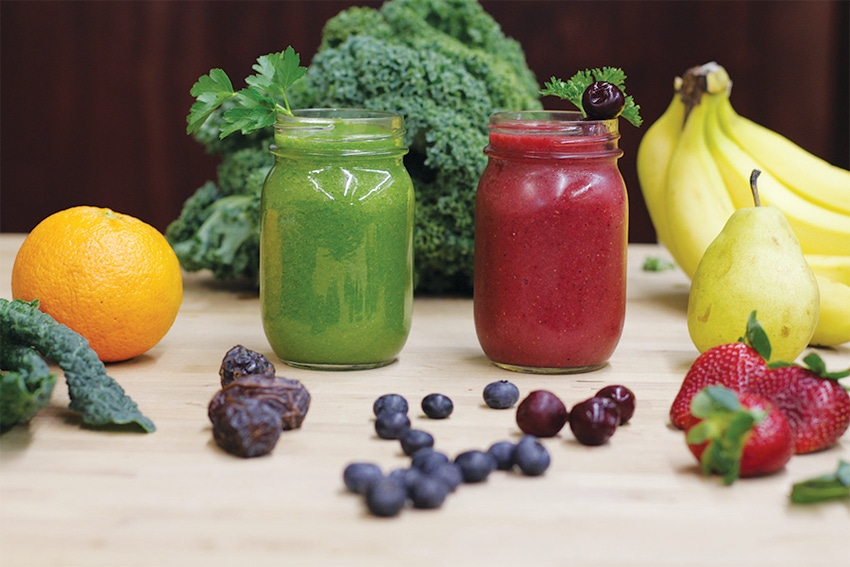Here's how natural retailers with foodservice can capitalize on growing demand for beverages with organic, free-from and non-GMO claims, and the desire for customization.
April 26, 2016

A just-released report from flavor consulting firm Fona International provides insights into millennials and their attitudes toward the all-important juice and smoothie category. The report, "€œMillennials and Juice Beverages," points out that millennials lead the pack in juice and smoothie consumption, using them as meals or snacks and and for heath and hydration. Fona also points out that juicing is a $2.3 billion per year business; and cold-pressed juice is a $100 million market. The good news for foodservice providers is that there are opportunities to grab a significant portion of the market share in this category.
Know your juices
HPP: High pressure processing is an alternative to traditional pasteurization that utilizes pressure instead of heat to eliminate the growth of pathogens. HPP extends the life of the juice product for up to three weeks.
Cold-pressed/raw or fresh: Any pasteurized juice product cannot be labeled “fresh.†Juices that are cold-pressed and fresh must be consumed within three days or their nutrients degrade. Restaurants and juice bars are well-positioned to offer fresh juices when they are juicing in front of customers and the juice has not been exposed to heat or pressure processing through its extraction.
Cold-pressed/HPP: Many bottled products found on store shelves fall into the cold- pressed/HPP category. These products are cold-pressed, then processed using HPP "€œto maintain the raw, fresh natural characteristics of the ingredients intact,"€ according to Fona.
Millennial mindset
When menuing your own juices and smoothies or choosing bottled products, label terminology matters, especially to younger millennials. Twenty-five percent of men and 20 percent of women aged 18 to 24 €œfind organic, 'free-from'€™ formulations and GMO claims influential in juice category decisions,€ according to Fona. Moreover, this target group has demonstrated a willingness to pay more for grocery products or restaurant offerings with these attributes if they perceive them to be healthier.
The ability to customize their food and beverage choices is an important feature to millennials. "Juicing's ingredient versatility fits those needs beautifully," the Fona report points out. The company found that 40 percent of these young consumers are "€œbored with standard fruit and juice flavors."€ Restaurants and manufacturers that provide innovative or customizable flavor blends have an advantage in winning over a portion of the juice and smoothie market.
Beyond techniques such as cold-pressed, HPP and raw, €œhandcrafted and artisan products have millennial appeal. "The human touch,"€ says Fona, suggests the "€œbest quality flavor." Products that boast artisan features perform well among millennial customers. Project Fresh, for example, introduced its Ripe Craft Juice in 2014, touting "€œalways cold pressed and unpasteurized/never heated or from concentrate."€ The brand also promises ingredient traceability in the near future, a move that may be targeted at millennials.
Foodservice on board
Savvy restaurants are menuing bottled HPP products when labor-intensive custom blending is not an option. Emerging businesses, such as Gypsy Juice Raw, in Denver, have begun to distribute their blended raw juices to the restaurant market.
Millennials'€™ penchant for fresh juices creates opportunities. One of these opportunities includes offering juice beyond breakfast. Juices and smoothies have functional benefits, the allure of sweetness, convenience and artisan qualities that appeal to this target group. €œPlus,€ points out the Fona report, "€œmillennials'€™ €˜clockless€™ eating schedule gives juice an edge, especially if it's fresh, premium and has phenomenal taste." Foodservice providers would do well to specify the origins of the their juices and smoothies they offer. Finally, "€œbar codes, batch identifiers or any way to show the source of ingredients in a juice would appeal to health- and clean label-conscious millennials,"€ says the Fona report.
 This piece originally appeared on restaurant-hospitality.com, a New Hope Network sister website. Visit the site for more restaurant trends insights.
This piece originally appeared on restaurant-hospitality.com, a New Hope Network sister website. Visit the site for more restaurant trends insights.
You May Also Like


